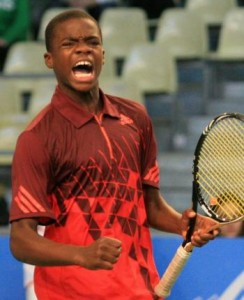by Andrew Eichenholz
Seventeen-year old Frances Tiafoe was up 6-1 5-1 against the top-ranked junior in the world, Andrey Rublev. in the quarterfinals of the 2014 U.S. Open Junior Championships. Next thing he knew, it was down to a deciding third set after a seemingly insurmountable lead and two match points went by the wayside.
Tiafoe would survive that match, but when he had two match points against Frenchman Quentin Halys in the next round, he would not be as fortunate, eventually losing.
Tiafoe turned pro on Monday. As he soon will realize, those mental letdowns and chances missed will mean more than a trip back to the academy. Every match counts to make a living in the sport of tennis. It will be up to the Maryland native to overcome the increasing pressure of the spotlight to do just that.
If anything, watching him in Flushing Meadows showed one thing—the kid enjoys the sport. Most players, junior and professional, spend their changeovers refueling for the next two games. Tiafoe chats up the ballpeople and lets his eyes wander his surroundings.
Those are some of the reasons that Jay Z and his management agency Roc Nation reached out and did everything they could to sign their first tennis player. They did not seek out Roger Federer or Serena Williams. They picked Tiafoe.
It is that type of energy that will push Tiafoe through the low moments of fighting for ranking points in the low-level tournaments with little to no crowd in sight. With a rifle of a forehand in tow, one day, the youngster will work his way to the top.
It is seemingly inevitable, is it not?
Much like current rising star Jack Sock, toting the red, white and blue, Tiafoe has a huge forehand, one that will be able to win him matches against many opponents. Again like Sock’s, it is not the prettiest thing in the world.
Whippy, awkward, out-of-the-blue. Watching his preparation for contact, nobody would expect the powerful, heavy ball that comes off of the strings of Tiafoe’s racket.
Yet, as he begins his professional career, that will be the weapon that makes his name. Tiafoe has a hard serve, albeit inconsistent and not the most technically efficient work of art in the world. His backhand is stiff and attackable.
Those things can change, with the help of coach Misha Kouznetsov and company. Tiafoe can and will get better in those departments.
What many misconstrue is that a player needs to spend all their time and resources on shoring up their weaknesses. In today’s sport, where matches can in many instances be controlled by one individual shot—Rafael Nadal’s forehand, Stan Wawrinka’s backhand, John Isner’s serve—it is equally as important to get the most out of a high-potential weapon. Tiafoe’s limit on the forehand wing is the sky. It can be one of the best shots in the sport, period.
The one problem that may arise is the weight of expectation. Donald Young was the next American superstar for years, turning pro at an even younger age than Tiafoe, making the move at the age of 14. His best result at a Grand Slam is a fourth round appearance at the 2011 U.S. Open.
That is a great accomplishment, and would be a dream come true for many tennis pros out there.
For the critics, however, that is not enough, and if Tiafoe were to only make it that far at a major early on in his career, it will be considered a failure. That is unfair, but it is what the young man faces as his game, life and career’s journey evolves.
When he finds himself in a battle, though, one has to believe that memories of the junior clashes he could have won will be lurking in his memory, pushing him to win that one more point.

